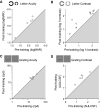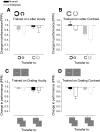The pattern of learned visual improvements in adult amblyopia
- PMID: 21810976
- PMCID: PMC3207721
- DOI: 10.1167/iovs.11-7584
The pattern of learned visual improvements in adult amblyopia
Abstract
Purpose: Although amblyopia is diagnosed in terms of a monocular letter acuity loss, individuals typically present with deficits on a wide range of spatial tasks. Many of these deficits can be collapsed along two basic visual dimensions (visual acuity and contrast sensitivity) that together account for most of the variability in performance of the amblyopic visual system. In this study, this space was exploited, to target the main deficits and fully characterize the pattern of learned visual improvements in adult amblyopic subjects.
Methods: Twenty-six amblyopic subjects (mean age, 39 ±12 years) were trained on one of four tasks, categorized as either visual acuity (letter or grating acuity) or contrast sensitivity (letter or grating contrast) tasks. Performance was measured on all tasks before and after training, to quantify learning along each dimension and generalization to the other dimension. Performance in 35 visually normal subjects (mean, age 24 ± 5 years) was used to establish normal variation in visual performance along each dimension, against which the learned improvements in amblyopic subjects was compared.
Results: Training on the contrast sensitivity tasks produced substantial within-task learning and generalization to measures of visual acuity. The learned improvements in performance after training on the letter acuity task were also substantial, but did not generalize to contrast sensitivity.
Conclusions: Mapping the pattern of learning onto the known deficit space for amblyopia enabled the identification of tasks and stimulus configurations that optimized learning, guiding further development of learning-based interventions in this clinical group.
Figures









References
-
- Ciuffreda K, Levi DM, Selenow A. Amblyopia: Basic and Clinical Aspects. Stoneham, MA: Butterworth-Heinemann; 1991
-
- von Noorden GK. Binocular Vision and Ocular Motility: Theory and Management of Strabismus. 5th ed St. Louis: Mosby; 1996
-
- Attebo K, Mitchell P, Smith W. Visual acuity and the causes of visual loss in Australia. The Blue Mountains Eye Study. Ophthalmology. 1996;103:357–364 - PubMed
-
- Wiesel TN, Hubel DH. Single-cell responses in striate cortex of kittens deprived of vision in one eye. J Neurophysiol. 1963;26:1003–1017 - PubMed
Publication types
MeSH terms
Grants and funding
LinkOut - more resources
Full Text Sources
Medical

